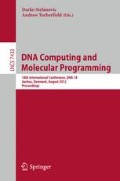Abstract
Splicing as a binary word/language operation is inspired by the DNA recombination under the action of restriction enzymes and ligases, and was first introduced by Tom Head in 1987. Shortly thereafter, it was proven that the languages generated by (finite) splicing systems form a proper subclass of the class of regular languages. However, the question of whether or not one can decide if a given regular language is generated by a splicing system remained open. In this paper we give a positive answer to this question. Namely, we prove that, if a language is generated by a splicing system, then it is also generated by a splicing system whose size is a function of the size of the syntactic monoid of the input language, and which can be effectively constructed.
This research was supported by the Natural Sciences and Engineering Research Council of Canada Discovery Grant R2824A01 and UWO Faculty of Science grant to L. K.
Access this chapter
Tax calculation will be finalised at checkout
Purchases are for personal use only
Preview
Unable to display preview. Download preview PDF.
References
Bonizzoni, P.: Constants and label-equivalence: A decision procedure for reflexive regular splicing languages. TCS 411(6), 865–877 (2010)
Bonizzoni, P., de Felice, C., Zizza, R.: The structure of reflexive regular splicing languages via Schützenberger constants. TCS 334(1-3), 71–98 (2005)
Bonizzoni, P., de Felice, C., Zizza, R.: A characterization of (regular) circular languages generated by monotone complete splicing systems. TCS 411(48), 4149–4161 (2010)
Bonizzoni, P., Ferretti, C., Mauri, G., Zizza, R.: Separating some splicing models. Inf. Process. Lett. 79(6), 255–259 (2001)
Bonizzoni, P., Jonoska, N.: Regular Splicing Languages Must Have a Constant. In: Mauri, G., Leporati, A. (eds.) DLT 2011. LNCS, vol. 6795, pp. 82–92. Springer, Heidelberg (2011)
Culik II, K., Harju, T.: Splicing semigroups of dominoes and DNA. Discrete Applied Math. 31(3), 261–277 (1991)
Gatterdam, R.W.: Splicing systems and regularity. International Journal of Computer Mathematics 31(1-2), 63–67 (1989)
Goode, E.: Constants and Splicing Systems. PhD thesis, Binghamton University (1999)
Goode, E., Pixton, D.: Recognizing splicing languages: Syntactic monoids and simultaneous pumping. Discrete Applied Math. 155(8), 989–1006 (2007)
Head, T.: Formal language theory and DNA: an analysis of the generative capacity of specific recombinant behaviors. Bull. of Math. Bio. 49(6), 737–759 (1987)
Head, T.: Splicing languages generated with one sided context. In: Păun, G. (ed.) Computing With Bio-molecules: Theory and Experiments, pp. 269–282. Springer (1998)
Head, T., Pixton, D.: Splicing and Regularity. In: Ésik, Z., Martín-Vide, C., Mitrana, V. (eds.) Recent Advances in Formal Languages and Applications. SCI, pp. 119–147. Springer, Heidelberg (2006)
Head, T., Pixton, D., Goode, E.: Splicing Systems: Regularity and Below. In: Hagiya, M., Ohuchi, A. (eds.) DNA 2002. LNCS, vol. 2568, pp. 262–268. Springer, Heidelberg (2003)
Hopcroft, J.E., Ullman, J.D.: Introduction to Automata Theory, Languages and Computation. Addison-Wesley (1979)
Kari, L., Kopecki, S.: Deciding whether a regular language is generated by a splicing system. CoRR, abs/1112.4897 (2011)
Pixton, D.: Regularity of splicing languages. Discrete Applied Math. 69(1-2), 101–124 (1996)
Păun, G.: On the splicing operation. Discrete Applied Math. 70(1), 57–79 (1996)
Schützenberger, M.P.: Sur certaines opérations de fermeture dans le langages rationnels. Symposia Mathematica 15, 245–253 (1975)
Author information
Authors and Affiliations
Editor information
Editors and Affiliations
Rights and permissions
Copyright information
© 2012 Springer-Verlag Berlin Heidelberg
About this paper
Cite this paper
Kari, L., Kopecki, S. (2012). Deciding Whether a Regular Language Is Generated by a Splicing System. In: Stefanovic, D., Turberfield, A. (eds) DNA Computing and Molecular Programming. DNA 2012. Lecture Notes in Computer Science, vol 7433. Springer, Berlin, Heidelberg. https://doi.org/10.1007/978-3-642-32208-2_8
Download citation
DOI: https://doi.org/10.1007/978-3-642-32208-2_8
Publisher Name: Springer, Berlin, Heidelberg
Print ISBN: 978-3-642-32207-5
Online ISBN: 978-3-642-32208-2
eBook Packages: Computer ScienceComputer Science (R0)

